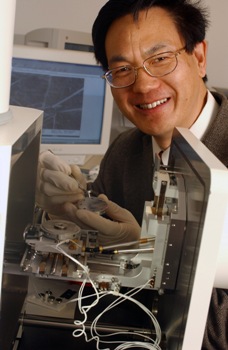Zhong Lin Wang, Regent’s Professor of the Georgia Institute of Technology has been awarded a 2011 Materials Research Society Medal for his technology innovations based on zinc oxide nanostructures on November 30 2011 at the society’s fall meeting conducted in Boston.
 Regent’s Professor Zhong Lin Wang has received a 2011 MRS Medal for his work on zinc oxide nanowires and nanobelts for a broad range of applications. (Credit: Nicole Cappello ).
Regent’s Professor Zhong Lin Wang has received a 2011 MRS Medal for his work on zinc oxide nanowires and nanobelts for a broad range of applications. (Credit: Nicole Cappello ).
The award has been presented to Wang for his works in the discovery and development of zinc oxide nanobelts and nanowires and the design and production of piezotronic devices, nanowire-based sensors and nanogenerators for energy production.
Wang is best recognized for his nanogenerator that produces electrical current using the zinc oxide nanostructures’ piezoelectric properties. Through extensive research, his research team has improved the output of the nanodevice and today a cluster of linked nanogenerators can generate as high as 30 V that is efficient to power up traditional electronic parts such as LED displays. The discovery of nanogenerators paved the way for the development of self-powered nanodevices.
Wang has also recently demonstrated piezotronics technology by manipulating charge transfer in electronic devices using the nanomaterial’s piezoelectric effect. The new technology is an ideal replacement for conventional CMOS technology. Moreover, he is the one who created the term ‘piezo-phototronics’ to depict technologies for manipulating electro-optical processes in equipment such as LEDs.
Wang gained international attention for the first time for his work on carbon nanotubes. His study with Walt de Heer on the vibration of nanotubes helped them to identify the nanomaterial’s approximate mass. They developed a device known as ‘Nanobalance.’ He then shifted its focus on oxide materials, especially zinc oxide.
Wang stated that with its attractive optical, piezoelectric and semiconducting properties, zinc oxide finds applications in transducers, sensors, energy harvesting and much more. He developed nanobelt and then synthesized an aligned zinc oxide nanowire array, which headed towards the fabrication of nanogenerators. In the recent years, he developed novel electronic components such as piezotronic memory and logic gates and enhanced LEDs using the piezo-phototronic effect. He designed self-powered sensing systems by combining different systems for detecting adverse materials. He also designed the first-of-its-kind hybrid cell by coupling different energy harvesting systems such as photovoltaic cells and nanogenerators.